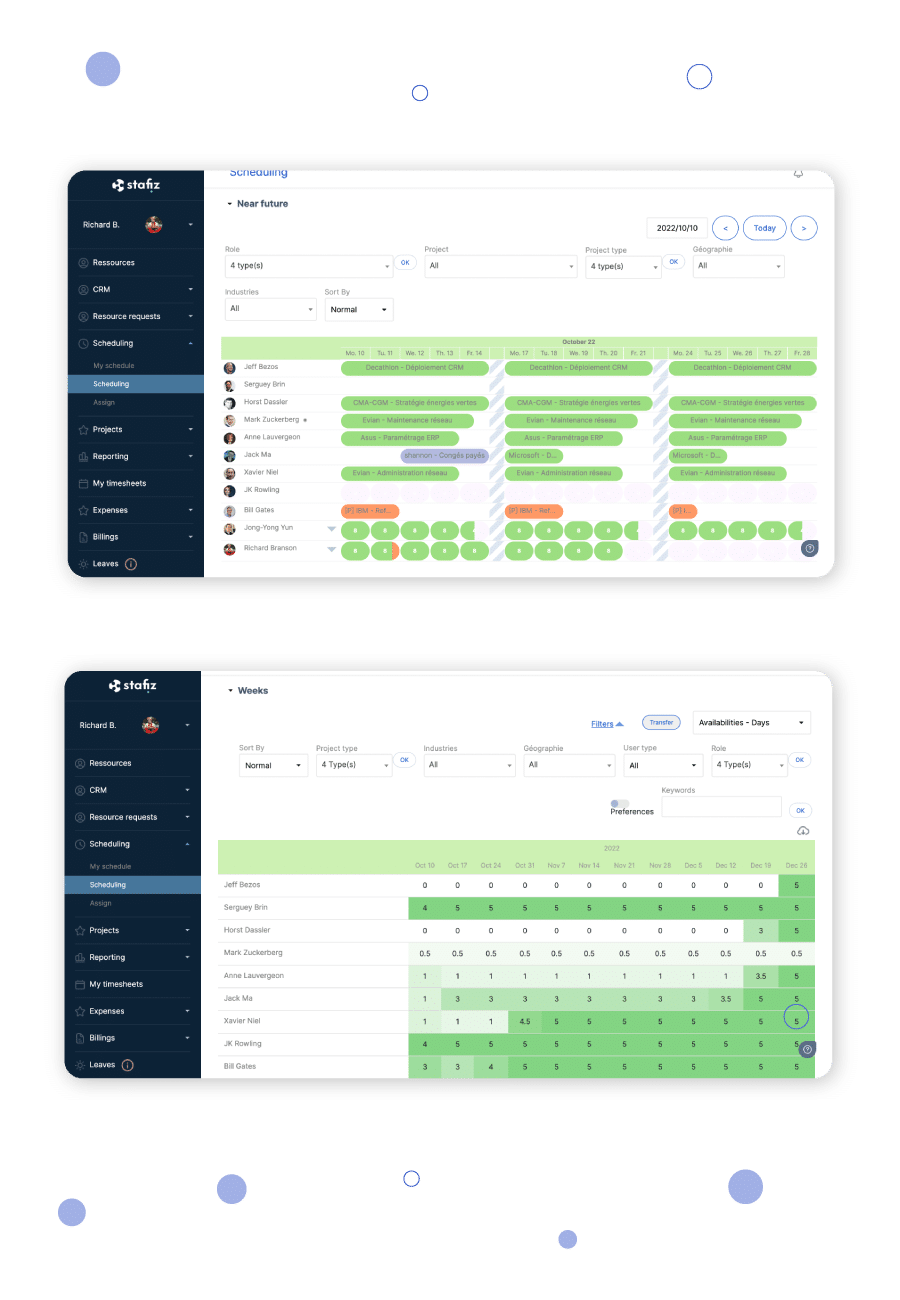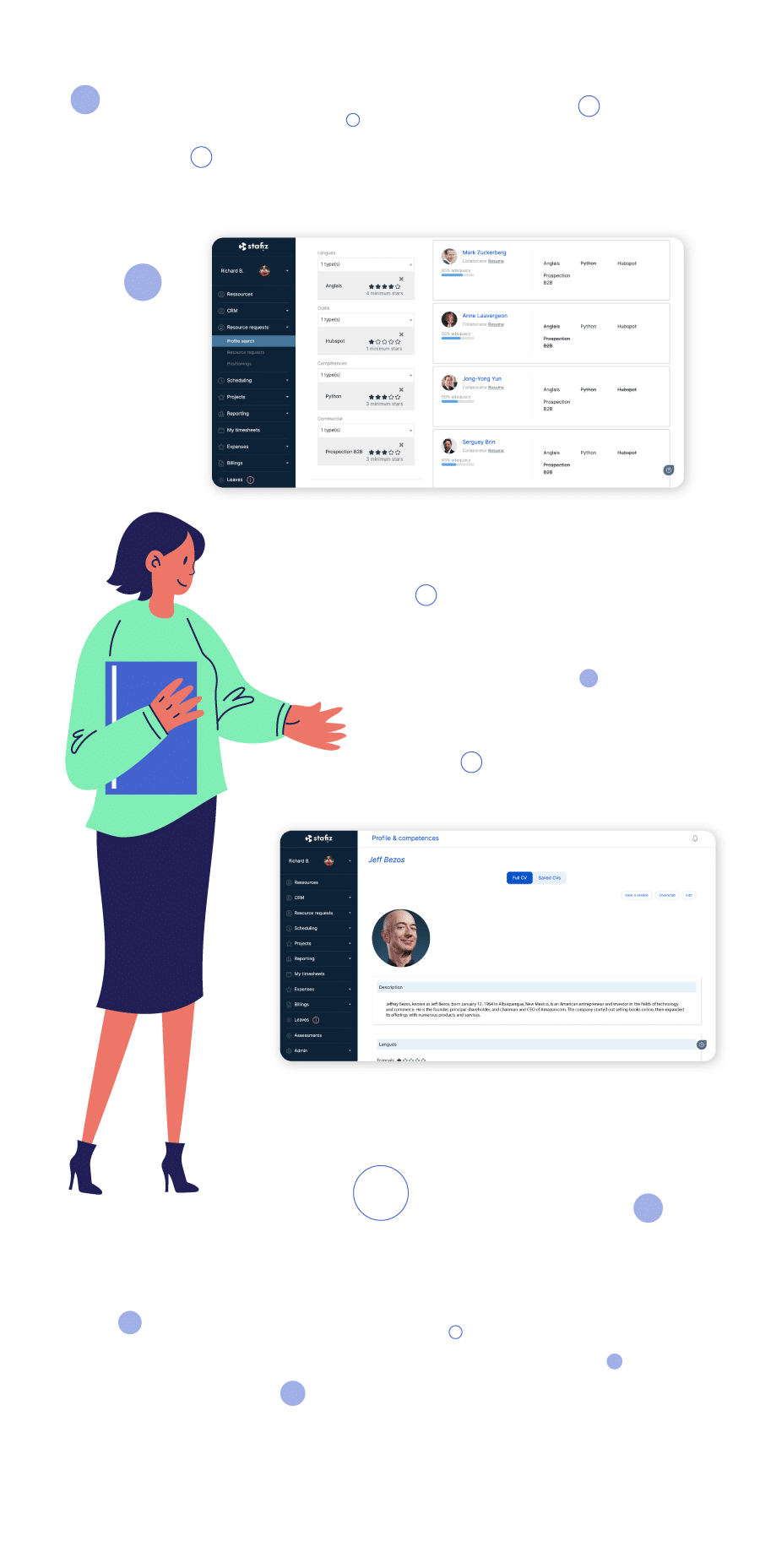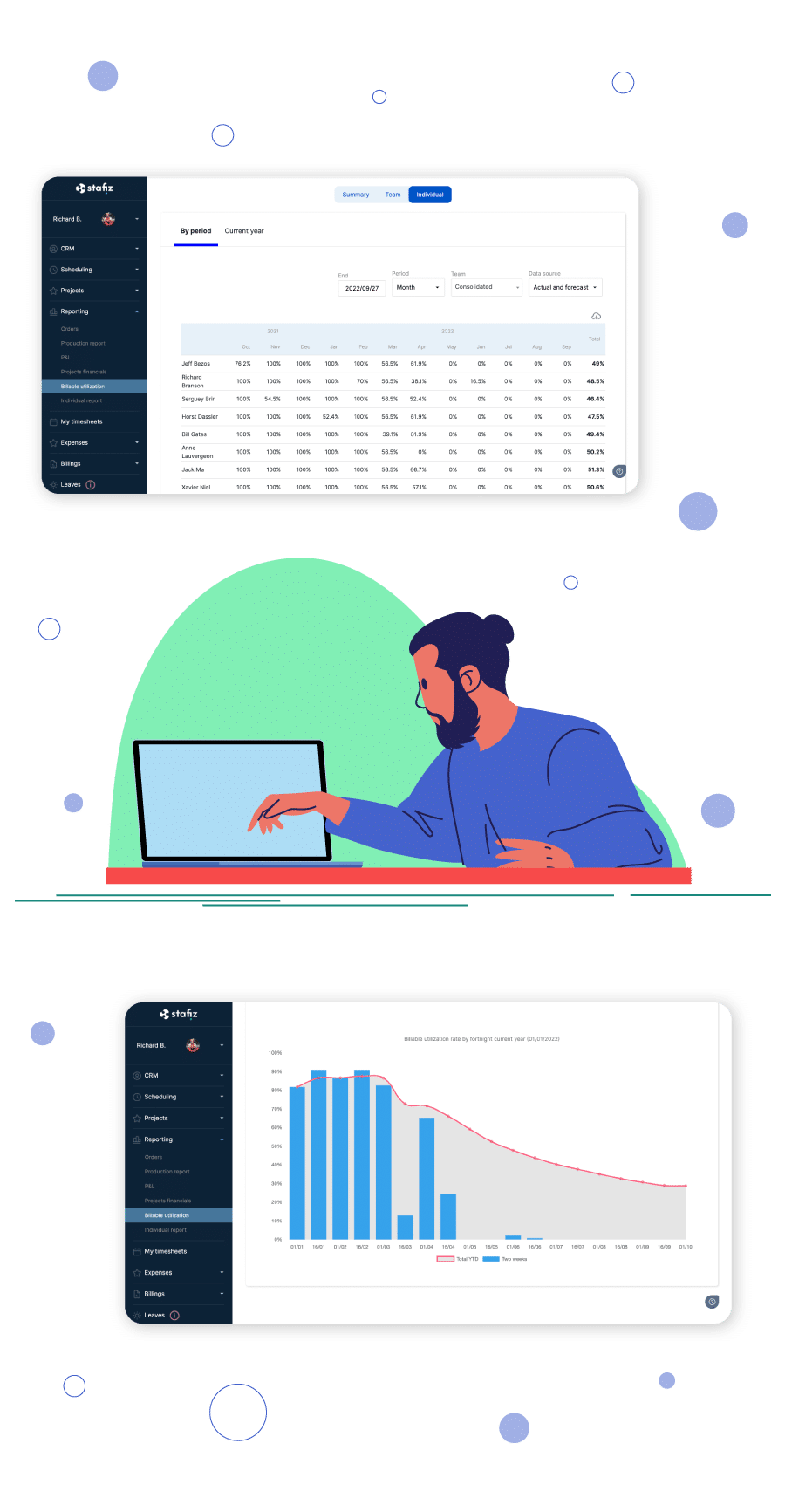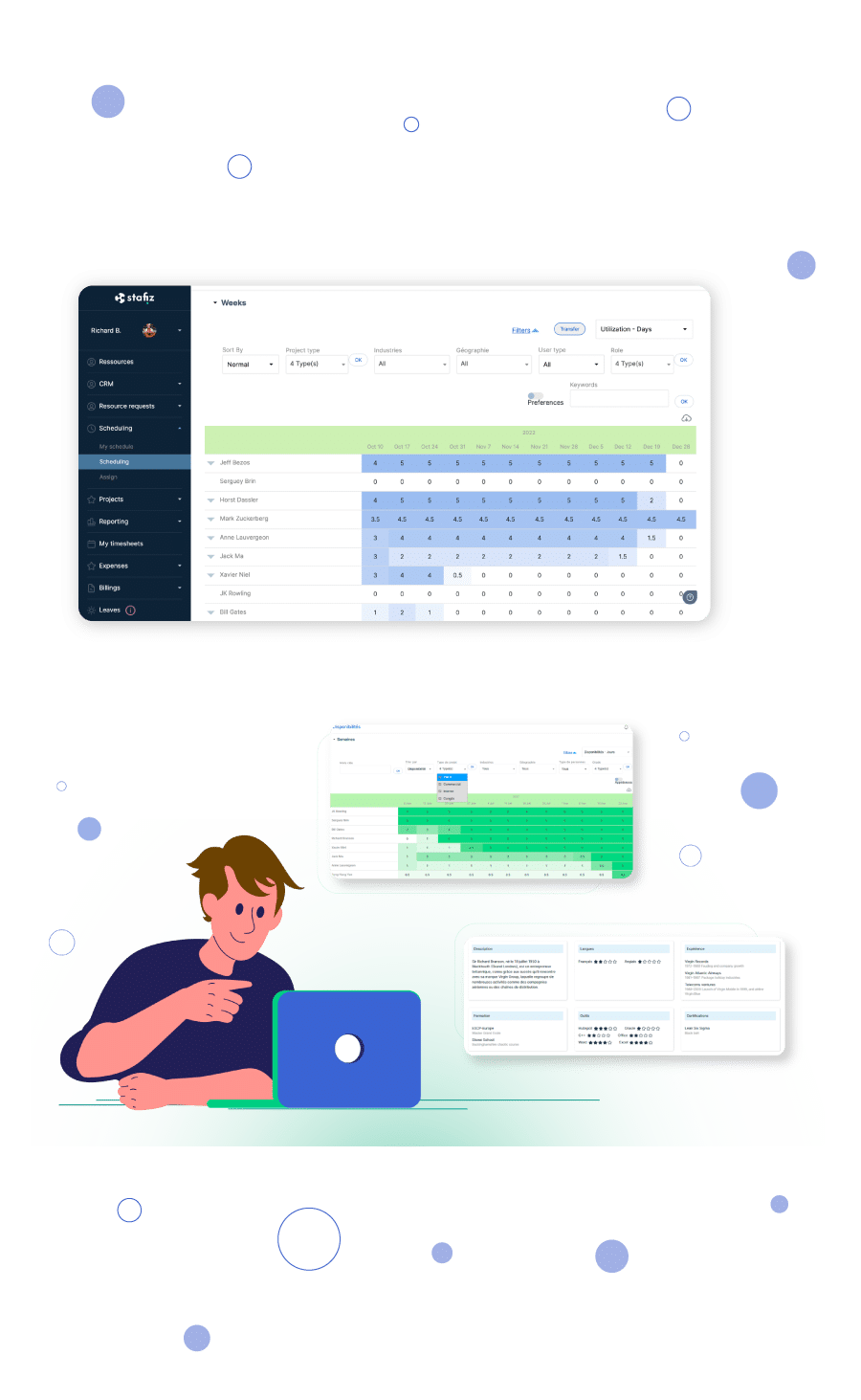Find out how Stafiz can help you manage your resource planning
Make an appointment to see a demo
Step 1
Implement effective resource planning requires combining the implementation of the right tools and managing change with the teams concerned. One cannot work without the other. Here are the steps to follow to set up a resource planning which will be the heart of the reactor of your growth.
The objectives expected of good management of resource planning can vary depending on the activity and priorities of each company. Among the main objectives listed below, it is important that you take a step back by defining which ones are priorities.
While they are all important, the approach may vary marginally depending on the order of priority.
a. Give visibility to employees
As soon as it is implemented, staff management provides visibility on the teams' schedule. Manage the resource planning, it is to follow the planning of the load, the assignments on projects and tasks. Regularly, employees lack visibility on their schedule of a few weeks.
They know their short-term schedule but lack visibility beyond that. By providing them with better visibility, you increase employee satisfaction, you give them more comfort because they can better project themselves and anticipate the implications of this schedule from a professional and personal point of view.
b. Facilitate load balancing to improve efficiency, and get projects to start faster
The professions that operate in project mode are well aware of the problems of "bottlenecks".
The very first bottleneck of a project is the lack of capacity of the teams.
By managing the resource planning With the right tools, abilities improve drastically and bottlenecks are reduced. Projects start faster because the organization is better oiled and visibility on everyone's capabilities is accentuated.
c. Optimize workload
In all project teams, the subjects of overload and underload penalize performance.
Employees who are overloaded cannot deliver their work as well and risk burnout, while employees who are under-burdened represent poorly exploited resources for the company and risk becoming demotivated.
Optimising the load to better distribute it and ensuring that everyone in the team is working at their right capacity promotes employee performance and satisfaction.
d. Search for profiles to meet needs
Resource planning can also be more focused on the process of searching for profiles according to criteria. Without a tool, it's difficult to keep track of requests, to enable a "match" between the need and the profiles that meet it. Whatever your objectives, make sure that management has set the right priorities, so that you can set the right standards when implementing your resource planning management system.

Make an appointment to see a demo
Step 2
By taking into account as much data as possible to manage the resource planning, you integrate more information that allows you to make the right decisions. Ideally, you create your profile database with the following data:
a. Names
This is a prerequisite for carrying out research and giving visibility to assignments.
In the medium term, load planning on a project can be applied on roles rather than names. But it is imperative to staff projects and tasks to particular people in the short term.
b. Roles & Teams
To better find profiles in the database, you need to assign them "tags" to make it easier to search.
Group them according to roles (developer, consultant, manager, etc.) or grades (junior, senior, etc.). If the teams are divided into poles or business units, it is also necessary to confirm which team each profile belongs to.
c. Skills
When you manage a resource planning For teams with more than thirty employees, it is necessary to take into account skills to better meet customer needs.
First of all, you need to establish a competency framework to update your profiles consistently. This reference system must be the same for your employees, your subcontractors and your candidates, so that the searches for your resource planning are as relevant as possible.
d. Preferences
By encouraging your employees to indicate their preferences among a repository of defined preferences, you allow you to take into account this criterion which will affect the satisfaction of your teams. Thus, employees must be able to indicate the type of project on which they would like to be positioned (for example: data science, marketing, aeronautics, etc.).
Although it is not always possible to exploit this data in a context of pressure on capacities, if you respond favourably in even 30% of cases, it will already make a huge difference for your employer brand and for the satisfaction of your employees.
e. Arrival and departure date
By nature, a schedule is in constant motion. Some employees are coming in, others are leaving the company. The dates of entry and exit must be integrated into the database, so that the calculation of capacities takes them into account. Otherwise, you risk staffing a profile that has already left the company.
f. Absences / part-time
For a capacity schedule to be useful, it is imperative to enter the periods during which your profiles are unavailable: holidays, stoppages and part-time periods.
Without this data, the management of the resource planning loses performance because crucial information is unavailable. Either your resource planning is connected by API to your HR absence management tool, or you regularly (on a weekly basis for example) import the absence data into your resource planning.

Step 3
Now that the database is ready, the load must be assigned to the different profiles. To do this properly, you need to establish the views that work for you. Here are the different options:
a. With dates, in hours
If the projects are short, i.e. they last between a few hours and a few days, you should choose to plan in hours and take a day-to-day view. In this case, it is probably important to know the precise dates of the assignments, or even the times defined in a day. Planning in calendar format is then the best option. Add a view of the resource planning with the days (take the one with the color bars)
b. Weekly or monthly
If the majority of projects last more than 5 days, it is preferable to follow the workload by the week. That is, to assign a number of days in a given week to a project. For example: assign in week 34 Bob Kennedy, 3.5 days on project XYZ Depending on the assignments on the different projects, the follow-up should allow you to know what his remaining availability is.
For projects that last several months, the same approach should be carried out at the granularity of months. Ideally, you choose the finest granularity that works for you, and consolidation allows you to see it at other time horizons. Add a view of the resource planning in % load (blue and red) with the weeks in columns
c. Per employee and per project
Your management of the resource planning must make it possible to manage the workload of employees. It is therefore necessary to have a global and accessible visibility that allows you to determine at a glance whether employees are underloaded or overloaded. But the management of the resource planning should also improve operational performance in several ways:
The assignment per employee must be transcribed into a project view: in each project, it is necessary to know what is the forecast time to be spent per employee and if necessary per task.

Step 4
Choosing a resource planning or create your own tool to manage the resource planning is a first step that makes it easier to set up the process. But for success to be guaranteed, it is imperative to support the implementation of the resource planning through a transformation that must involve the various managers and make it possible to obtain their support.
The first step is to explain the reasons for better management of the resource planning. By detailing the following reasons, the perceived benefits to management and managers should be enough to find an alignment:
i. Increase in the profitability of the business
ii. Improved employee satisfaction
iii. Time savings
iv. Improved customer satisfaction
v. Sales benefits

To ensure that the management of the resource planning is optimal, it is necessary to be able to carry out group arbitrations, under the responsibility of the management. The same profile is often adapted for different needs. It is necessary that a single person can ultimately determine which project to assign these highly sought-after profiles to. Companies that effectively manage the resource planning meet regularly, often once a week, to take stock of:
This type of body generally brings together the operations manager and his or her main managers and allows the resource planning at the centre of operations.
c. Helping managers ensure that updates are made regularly
Finally, the resource planning That is, everyone's business. Every project manager needs to be involved to update the workload of the collaborators who work on their projects.
He is the one who has the best visibility to predict the load to come. By empowering teams so that updates are made regularly, you benefit from a much more relevant consolidated visibility. Data reporting should not depend on a single planner, but should be distributed among stakeholders.
These officials must be encouraged to make this update. It should allow them to improve the performance of their project and the satisfaction of their teams, which can contribute to the achievement of their objectives.

To learn more about the Stafiz platform, visit the product page.